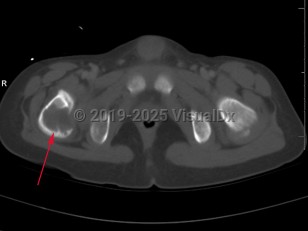Eosinophilic granuloma of bone in Child
Alerts and Notices
Important News & Links
Synopsis
Langerhans cell histiocytosis (LCH) refers to a spectrum of diseases that includes eosinophilic granuloma (EG), Hand-Schuller-Christian disease, and Letterer-Siwe disease. EG is a rare (seen in 1-5 per million), benign tumor-like disorder that features clonal proliferation of Langerhans cells (antigen-presenting mononuclear cells of dendritic origin) usually found in bones; however, this can involve other organ systems. EG occurs most often in children aged 5-15 years, with a male-to-female ratio of 2:1. EG constitutes 60%-80% of cases of LCH and accounts for less than 1% of all bone tumors. Ninety percent of cases involve a single lesion, usually in the axial skeleton, with just under 10% of cases involving lesions in multiple bones or lesions in other organ systems (ie, skin, pituitary gland, gastrointestinal [GI] tract, lung, spleen, or brain).
The clinical presentation of EG depends largely on the location affected. EG is most often confined to the axial skeleton. EGs are often asymptomatic and found incidentally, or may initially present with pain and swelling of the affected area, with or without decreased range of motion. Commonly affected areas of the skeleton include (in order of frequency): skull, femur, pelvis, mandible, clavicle, ribs, and long bones (of the diaphysis and metaphysis).
Within the spine, EG accounts for 6.5%-25% of all spinal tumors, with the most common location being the thoracic spine, followed by the lumbar and then cervical spine. In cases of EG of the spine, the following symptoms have been reported: neck / back pain, limb weakness, neck / back stiffness with restriction of movements, kyphotic deformity, radiculopathy, and torticollis.
The clinical presentation of EG depends largely on the location affected. EG is most often confined to the axial skeleton. EGs are often asymptomatic and found incidentally, or may initially present with pain and swelling of the affected area, with or without decreased range of motion. Commonly affected areas of the skeleton include (in order of frequency): skull, femur, pelvis, mandible, clavicle, ribs, and long bones (of the diaphysis and metaphysis).
Within the spine, EG accounts for 6.5%-25% of all spinal tumors, with the most common location being the thoracic spine, followed by the lumbar and then cervical spine. In cases of EG of the spine, the following symptoms have been reported: neck / back pain, limb weakness, neck / back stiffness with restriction of movements, kyphotic deformity, radiculopathy, and torticollis.
Codes
ICD10CM:
C96.6 – Unifocal Langerhans-cell histiocytosis
SNOMEDCT:
238476000 – Eosinophilic granuloma of bone
C96.6 – Unifocal Langerhans-cell histiocytosis
SNOMEDCT:
238476000 – Eosinophilic granuloma of bone
Look For
Subscription Required
Diagnostic Pearls
Subscription Required
Differential Diagnosis & Pitfalls

To perform a comparison, select diagnoses from the classic differential
Subscription Required
Best Tests
Subscription Required
Management Pearls
Subscription Required
Therapy
Subscription Required
References
Subscription Required
Last Reviewed:03/18/2024
Last Updated:04/04/2024
Last Updated:04/04/2024
Eosinophilic granuloma of bone in Child

